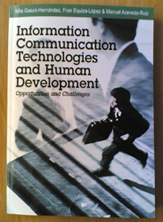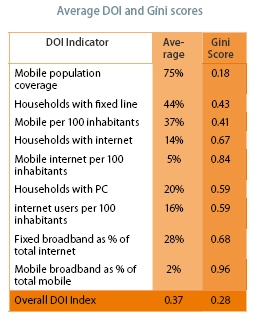By Ismael Peña-López (@ictlogist), 20 December 2006
Main categories: Education & e-Learning, ICT4D
No Comments »
This monograph is intended to help educational decision makers survey the technological landscape and its relevance to educational reform. This monograph is firmly rooted in a vision of education that begins with the learner and attempts to understand how technological tools can better contribute to educational goals. It looks at how technology can promote improvements in reach and delivery, content, learning outcomes, management of systems, teaching, and pertinence. In short, it is a contribution to global reflection on how to make learning throughout life a reality.
This new UNESCO/AED book, edited by Wadi Haddad and Alexandra Draxler and authored by a good collection of authors, presents some reflexions on how ICTs can help Education reach those that are unreachable by traditional educational means — thus, while not “for development” focused, it is indeed mainly targeted to people and institutions working for population under exclusion risks, specially those in developing countries.
My opinion is that the book is half complete. The articles chosen are really relevant, but there is a serious lack of strategical perspective. In other words, the actual situation being well described, there is no forecast on the current debates on instructional technologies and their immediate future. To note, two of the most prominent things absent in the book: free and/open source software for education (FLOSSE) and open educational resources (OER). The reason might be the date of the publication of the book: 2002. I know this is quite unhumble from my part, but I’d suggest taking a look at my master’s thesis e-Learning for Development: a model to complement the issues of OER and FLOSSE.
More info
[via]
By Ismael Peña-López (@ictlogist), 14 December 2006
Main categories: ICT4D
No Comments »
Mila Gascó Hernández, Fran Equiza López and Manuel Acevedo Ruiz have released a new book on ICT4D: Information Communication Technologies and Human Development: Opportunities and Challenges
Technology has always played a decisive role in humanity’s progress, although the positive impacts technology has on human development may become tainted by the risks it entails. Information Communication Technologies and Human Development: Opportunities and Challenges emphasizes the need to consider the geographic, historic, and cultural context of an information communication technology (ICT) for development initiative, and includes several real examples that show some of the key success factors that have to be taken into consideration when using ICTs for development. Information Communication Technologies and Human Development: Opportunities and Challenges is a tool for practitioners, providing a wide knowledge of several important ICTs for development experiences that have been conducted all over the developing world.
The first feeling is that the authors compose a good team of experts and that the approach of the book is eminently practical, way far from theory. In this first glance I can notice that the bibliographies are terrific — and you wish you’d never looked ad them and found so many unread resources.
The table of contents can be found here, where you’ll find a very appropriate and timely article for these days about microcredit by Narima Amin. It’s a pity the editors did not sign themselves more content than the 10 pages preface, as they surely have interesting things to explain.
By Ismael Peña-López (@ictlogist), 12 December 2006
Main categories: Offtopics, Setup
2 Comments »
Almost one year ago, I wrote about ICT4D Bibliography, the then new section of my personal research portal. It was published with an application I coded on my own, BibCiter, to replace the MS Access I had been using.
I began coding in Summer 2005 and after Christmas 2005, I could start using it for my own needs, as you could see. A year has passed and now I’m glad to announce that BibCiter has been fixed and enhanced and released as free software under a GPL v2 license. The baby is still too young to be a stable 1.0 version, so keep in mind that there are serious reasons for being 0.9 beta. Nonetheless, BibCiter [babe sitter] is fully functional and “only” lacks a good handbook.
Feel free to write back and send any comments… and, of course, feel free to install it!
More info
I want to hearty thank …dilluns… for her endless patience during endless PHP-MySQL sessions :*
By Ismael Peña-López (@ictlogist), 12 December 2006
Main categories: Connectivity, Hardware, ICT4D
No Comments »
Michael Trucano and Marco Zennaro respectively sent me two resources concerning ICT Infrastructures, both of them published by the World Bank.
The first one is the updating of the Quick guide to low-cost computing devices and initiatives for the developing world. The guide is a short inventory of known projects related to ‘low cost ICT devices for the developing world’
authored by Michael Trucano himself. While the list looks quite complete to me, I’d rely on the accuracy of a previous work of him, Knowledge Maps: ICTs in Education, to sincerely believe that the list is surely complete.
The second one is World Bank Working Paper no.27 Telecommunications Challenges in Developing Countries: Asymmetric Interconnection Charges for Rural Areas, by Andrew Dymond. Going against what tradition has dictated, Dymond states that the solution for the last mile problem should not be — as it usually happens — subsidies, but asymmetric (i.e. not the same for everyone) pricing, to adjust what end users pay to the cost of providing them with connectivity. Though the approach is quite unheard of and really defying, he provides examples on how this new scenario could be possible… and even desirable by the end users themselves — let aside the companies.
For those new to Dymond, he coauthored — with Sonja Oestmann — the handbook Rural ICT Toolkit For Africa, and — with Juan Navas-Sabater and Niina Juntunen — the well-know book Telecommunications and information services for the poor. Toward a Strategy for Universal Access.
By the way, infoDev’s ICT Regulation Toolkit has also been updated and should be almost complete by January 2007.
By Ismael Peña-López (@ictlogist), 11 December 2006
Main categories: Connectivity, Hardware, ICT4D
No Comments »
The “VoIP-4D Primer” is a free guide available in four major languages [Arabic, English, French and Spanish]. The work is an effort to disseminate the use of telephony over the Internet in developing regions.
The 40-page guide targets both technical and non-technical readers. The first part presents the essentials of telephony over the Internet. For those interested in the more technical details, hands-on guidelines and configuration files are included in the second part. The examples provide essential background to build your own low-cost telephony system.
The primer is authored by Alberto Escudero Pascual and Louise Berthilson — backed up by a team of translators, editors and reviewers — and describes in full detail all the hows and whys in setting up your own Voice over IP infrastructure.
More info:
By Ismael Peña-López (@ictlogist), 04 December 2006
Main categories: Connectivity, Digital Divide, Hardware, ICT4D
2 Comments »
Prepared especially for ITU TELECOM World (December 4-8 2006 in Hong Kong), the 8th in the series of ITU Internet Reports, entitled digital.life, begins by examining the underlying technologies for new digital lifestyles, from network infrastructure to value creation at the edges. In studying how businesses are adapting to fast-paced digital innovation, the report looks at how they can derive value in an environment driven by convergence at multiple levels. Moreover, a great challenge lies in extending access to underserved areas of the world. In light of media convergence, a fresh approach to policy-making may be required, notably in areas such as content, competition policy, and spectrum management. And as our lives become increasingly mediated by digital technologies, digital identities (both abstract and practical) take on a new dimension. Concerns over privacy and data protection do not seem to be sufficiently addressed by today’s online environments. In this context, the report examines the changing digital individual, and outlines the need for improving the design of identity management mechanisms for a healthy and secure digital world.
Besides this general quotation, the one I really subscribe is the following one, as it deals with something often said in our pages:
the nature of the digital divide is shifting from a primarily quantitative phenomenon (some countries and some regions have more ICTs than others) to a qualitative one (users have access to better quality, more affordable ICTs in some countries and regions than in others). In this context, the narrowband/broadband divide is a key measure.
One of the musts in this report is, no doubt, box 3.3 about digital divide measuring, specially the Gini scores for 9 indicators of the Digital Opportunity Index (DOI). The previous statement about the mobile narrowband/broadband digital divide comes out perfectly clear with a Gini score of 0.96. But, on the other hand, the most curious thing is that mobile (coverage) becomes the most democratic (and egalitarian) technology of all, with a Gini score of 0.18. It thus makes sense, as practitioners have demonstrated again and again, to focus ICT4D projects on mobile technologies.
A very entertaining and pleasant reading.
More info:
 Technologies for Education: Potential, Parameters, and Prospects (1.52 Mb)
Technologies for Education: Potential, Parameters, and Prospects (1.52 Mb)



